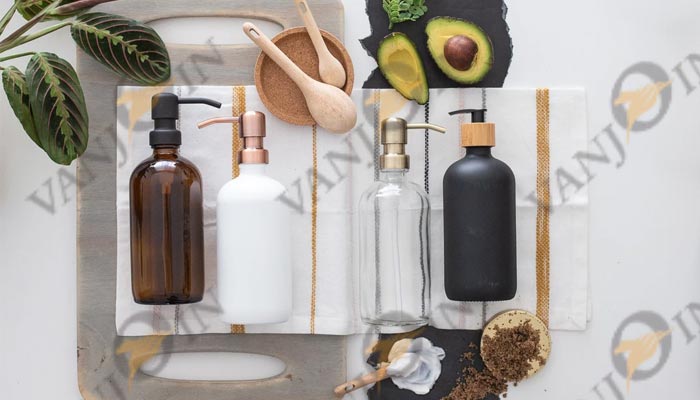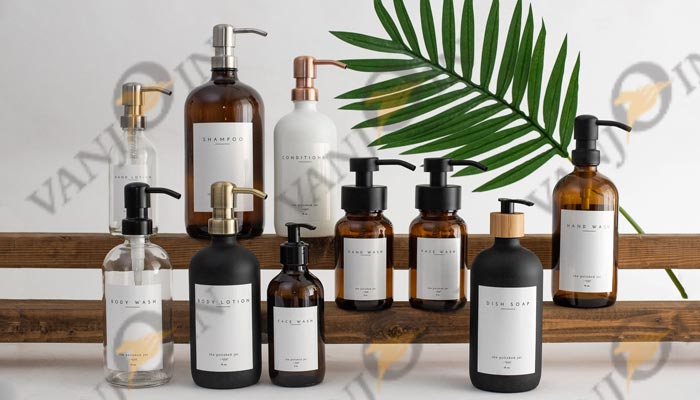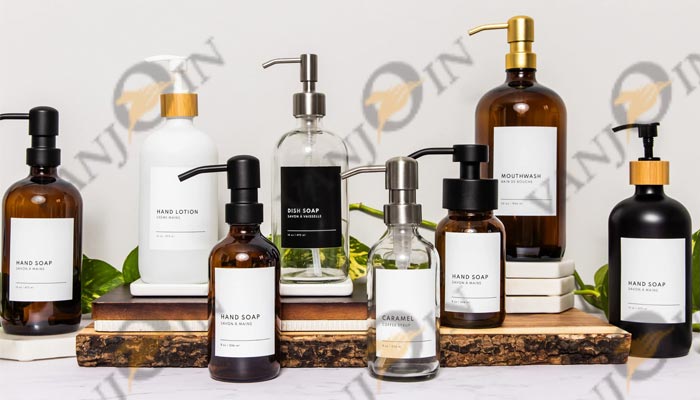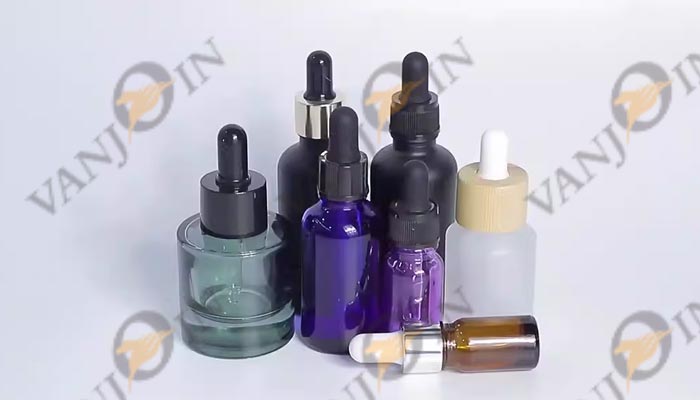
Amber vs clear glass bottles is one of the most controversial issues when selecting the right packaging for your products. You might have wondered: Which has better UV protection? What is more attractive on the shelf? Which of them is more environmentally friendly? Don’t worry. In this guide, we will unravel the key differences and major distinctions between the two common forms of glass bottle packaging to enable you to make an informed choice.

What Are Amber and Clear Glass Bottles Made Of?
Firstly, both amber and clear glass bottles may appear as nothing more than… glass. However, the reality is that their composition speaks otherwise. Soda-lime glass, a combination of silica, soda, and lime, is used to make clear glass bottles. This is what makes them have that crystal-clear look, and thus, they are the most preferred in products where appearance is important, such as gourmet oils or pharmaceutical packaging that requires customers to see the product inside.
Conversely, amber glass bottles contain iron, sulfur, and carbon compounds in the manufacturing process, which gives them the characteristic dark brown color. This is not only cosmetic! The color is important in filtering out the harmful ultraviolet radiations- UVB light and part of the UVA light. This additional protection is essential in industries such as the personal care industry and products such as essential oils to avoid quality loss and prolong shelf life.
How Light Affects Products in Amber vs Clear Glass Bottles
Now, we should discuss the greatest issue with clear glass bottles, which is light exposure. UV radiation is usually sensitive to products such as oils, pharmaceuticals and beverages. Exposure to UVB light or UVA light may result in chemical changes which may result in discoloration, loss of potency or even spoilage. A substantial quantity of UVB light may be particularly harmful to such objects as essential oils or a bottle of beer placed under direct sunlight.
Amber glass comes to the rescue there. Its dark color aids in the absorption and blocking of ultraviolet radiation, which offers the best protection to sensitive products. Although clear glass does not provide much protection, amber bottles can significantly decrease the level of UV exposure, which will keep your product quality and appearance intact. When you are dealing with a sensitive product, particularly one that is easily damaged by light, the type of glass you use may be the difference between a successful brand and a failed brand.

Pros and Cons of Using Amber Glass Bottles
What is so special about amber glass bottles then? To begin with, they are a perfect choice when it comes to light-sensitive products such as essential oils, serums, and pharmaceuticals because of their capacity to offer varying degrees of protection against UV light and rays. Consider items that remain on shelves of stores weeks, months… or even years! The amber color will serve as a natural sunscreen to your product by shielding it against light wavelengths and blocking a large amount of UVB light that may degrade the quality of your product with time.
However, we can not sugarcoat it, amber is not perfect in everything. In case the visual appeal is the most important factor, amber packaging may seem slightly drab in comparison to the clean appearance of clear bottles. The product is not visible to the customer, and this may influence the purchase of goods that are appealing to the eyes such as infused oils or colored bath salts. And, to add to that, amber bottles may be considered… well… a bit too pharmaceutical. Therefore, they can be victorious in terms of UV protection but defeated in terms of aesthetic appeal.
| Pros of Amber Glass Bottles | Cons of Amber Glass Bottles |
| Excellent UV protection — blocks harmful UVB and some UVA rays | Limited product visibility — customers can’t see the product inside |
| Ideal for light-sensitive products (e.g., essential oils, serums) | Less visually appealing — may look dull or “pharmaceutical” |
| Helps extend product shelf life and preserve potency | May not suit premium or decorative product displays |
| Suitable for long shelf storage in retail environments | Perceived as more clinical than cosmetic or luxury |
| Naturally protects without requiring additional packaging layers | May not align with branding focused on transparency or aesthetics |
Pros and Cons of Using Clear Glass Bottles
Let’s change gears now and discuss clear glass bottles, one of the most common types of glass bottle packaging. There’s no denying they scream elegance and purity. If you are selling items where color, clarity, or texture is a value add—like in the personal care industry, bath oils, gourmet vinegars, etc.—clear glass lets your product shine, literally. They’re often preferred by marketing-driven brands that want the product to do all the talking.
But… clear glass bottles fail when it comes to UV protection. They allow a significant amount of UVB light and other forms of ultraviolet radiation to come through, which offers only adequate protection at best and often little protection for your products susceptible to degradation. This means that light damage is a real risk for sensitive formulations, leading to quality loss over time. Deteriorating valuable contents makes clear bottles an unideal packaging option for sensitive substances unless stored in dark environments during transport or shielded with opaque secondary packaging to prevent direct sunlight exposure. Simply put, clear glass offers much UV protection? Not really.
| Pros of Clear Glass Bottles | Cons of Clear Glass Bottles |
| High visual appeal — showcases color, texture, and clarity of product | Poor UV protection — allows UVB and UVA light to pass through |
| Enhances product visibility — ideal for decorative and aesthetic items | Not suitable for light-sensitive products without extra protection |
| Preferred by marketing-driven and premium brands | Can lead to faster degradation or spoilage of contents |
| Great for personal care, gourmet foods, and decorative packaging | Often requires secondary packaging or special storage to prevent damage |
| Clean, modern, and luxurious appearance | Shorter shelf life for sensitive formulas exposed to light |
Best Use Cases for Amber vs Clear Glass Bottles
So… when do you choose amber over clear glass bottles? Choosing the right glass, amber glass bottles are the best option when it comes to products such as essential oils, pharmaceuticals, herbal tinctures, and anything that despises the sun. They are also common in the pharmaceutical packaging industry and are commonly used in craft beer due to their UV protection properties.
On the other hand, when you sell products that can be enhanced with visual merchandising, such as colorful bath oils, cooking sauces, or decorative candles, clear glass bottles are a winner (both literally and figuratively). They are frequently selected in the personal care sector in lotions, oils and perfumes where the aesthetics are as important as the functionality. Green glass packaging and cobalt glass bottles are middle-ground options, with varying degrees of protection and distinct visual aesthetics to brands that desire… something… different.
Shelf Life and Product Stability: Amber vs Clear Glass
This is where it gets serious. Your product shelf life can either build or break your business reputation. The products in amber bottles tend to have a longer shelf life because of the reduced exposure to UV rays. This is especially important in volatile preparations such as essential oils, herbal extracts, and certain pharmaceuticals. Limited light exposure also contributes to stability, color, and scent.
In clear glass bottles, there is a higher chance of losing quality, particularly when the products are exposed to direct sunlight or intense artificial lights in the retail stores. Although clear glass can score in terms of visibility, it usually fails in terms of the performance of sensitive products. Your product may lose its stability unless you are willing to take additional protective steps, such as external UV coatings or secondary packaging.

Sustainability and Recycling of Amber vs Clear Glass
And the eco-angle, too, we must not forget! Amber and clear glass bottles are both high in the recyclability score. But there is a twist. Clear glass is more likely to be demanded at the recycling plants as it can be more easily converted into new glass products of any color, including green glass or cobalt glass.
Conversely, amber glass, due to its darker pigmentation, can be downcycled into more amber packaging or darker materials. Nonetheless, switching to amber bottles may be regarded as a sustainable step, at least when you are concerned with shelf life, waste reduction caused by spoilage, and the necessity of preservatives. The trade-off between optimal protection and recyclability is a common consideration by eco-conscious brands in the personal care industry and food sectors when they make their packaging choices.
How to Choose Between Amber and Clear Glass Bottles
| Decision Factor | Amber Glass Bottles | Clear Glass Bottles |
| UV Protection | Excellent – Blocks harmful UVB and some UVA rays. Ideal for light-sensitive products. | Poor – Offers little to no UV protection. Not ideal for sun-exposed or sensitive contents. |
| Product Visibility | Low – Product not visible; can hide attractive colors or textures. | High – Allows full visibility of product, great for colorful or visually appealing formulations. |
| Shelf Life & Product Stability | Longer shelf life for sensitive products; protects from degradation. | Shorter shelf life for sensitive products unless extra protection is used. |
| Brand Image & Aesthetics | Functional and protective but may look pharmaceutical or plain. | Premium, clean, modern look; enhances product presentation. |
| Best for Product Types | Essential oils, pharmaceuticals, serums, herbal tinctures, craft beer. | Perfumes, gourmet oils, bath salts, decorative candles, specialty beverages. |
| Storage & Display Environment | Ideal for retail displays with direct or intense lighting. | Best for controlled environments or products stored in boxes/secondary packaging. |
| Sustainability & Recycling | Highly recyclable but mostly downcycled into darker glass. | Highly recyclable and more versatile in glass recycling streams. |
| Target Market & Branding Priorities | Performance-driven brands focusing on product protection and longevity. | Marketing-driven brands emphasizing transparency and visual appeal. |
| Additional Packaging Needs | Often no additional protection needed. | May require UV-blocking outer packaging or dark storage. |
Not convinced yet about amber vs clear glass bottles? Let us make the decision-making process simple. The first question you should ask yourself is: Is my product light-sensitive? Will it be in direct sunlight or high intensity artificial lights? In case the answer is yes, then you should probably use amber glass bottles or blue glass bottles with their UV protection capabilities.
However, when the aesthetic value of your product is more important to sales, such as with decorative oils, colorful serums, or specialty beverages, clear glass bottles might be the better option, but you should take measures to reduce light exposure. Finally, consider the nature of your product, your storage facilities, your target market and even your attitude towards sustainability and recycling. The correct glass is not only capable of safeguarding your product but also assisting in the narration of your brand.
Need High-Quality Glass Bottles for Your Business? Partner with Vanjoin
In the case of amber vs clear glass bottles, the correct decision is not only about the beauty of the bottle but also about the protection of the product, the differentiation of the brand, and the success in the market in the long term. Be it personal care industry, cosmetic packaging, beverage industry, or essential oils manufacturing, the selection of the right glass container is essential to the stability of the product, UV protection, and the appearance.
We are a major manufacturer of glass bottles at Vanjoin with a large-scale B2B production. Our product range encompasses a complete range of products such as amber glass bottles with the best UV protection and clear glass bottles with maximum visibility and shelf appeal. We also manufacture green glass, cobalt glass and other specialty glass to offer varying degrees of protection against light exposure and UV radiation.
What is more important is that we provide custom manufacturing services according to your business requirements. Need special shapes of bottles, special neck finishes, special colors, or special surface treatments (frosting, painting, screen printing, or labeling) we can do it all. We take care of the concept development to bulk production so that every bottle we produce fits your brand and performance needs.

Conclusion
The decision to use amber or clear glass bottles depends on the needs of your product and brand. Amber glass offers better UV protection and is the best choice when dealing with light-sensitive products, which increases shelf life and product stability. Clear glass, however, provides a good product visibility and aesthetic value and is thus ideal in displaying goods that are visually appealing. Both of them can be recycled, but they have varying effects on the environment. Finally, the packaging option you use must be in line with the sensitivity of your product, positioning, and sustainability objectives. Vanjoin is your reliable partner in delivering both protection and visual appeal to your packaging with tailored, high-quality glass solutions.